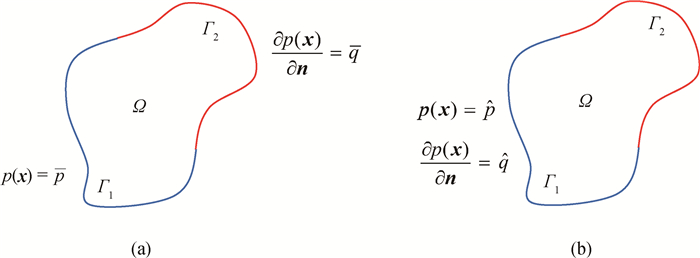计算物理 ›› 2022, Vol. 39 ›› Issue (6): 687-698.DOI: 10.19596/j.cnki.1001-246x.8520
吴国正1( ), 王发杰1,2,*(
), 王发杰1,2,*( ), 程隋福1, 张成鑫1
), 程隋福1, 张成鑫1
收稿日期:2022-02-25
出版日期:2022-11-25
发布日期:2023-04-01
通讯作者:
王发杰
作者简介:吴国正, 男, 硕士生, 研究方向为计算物理, E-mail: wgz980518@163.com
Guozheng WU1( ), Fajie WANG1,2,*(
), Fajie WANG1,2,*( ), Suifu CHENG1, Chengxin ZHANG1
), Suifu CHENG1, Chengxin ZHANG1
Received:2022-02-25
Online:2022-11-25
Published:2023-04-01
Contact:
Fajie WANG
摘要:
针对频域内部声场正反问题的数值模拟, 建立基于物理信息的神经网络架构。与基于数据驱动的神经网络不同, 将声学问题的Helmholtz方程及其对应的边界条件引入神经网络, 所建立的神经网络算法不仅能够反映训练数据样本的分布规律, 而且也遵循由偏微分方程描述的物理定律。考虑到频域声学问题中含有复数部分, 建立两种网络架构, 并进行验证和比较分析。该方法无需网格划分和数值积分等繁琐的数值计算过程, 可自由地处理不规则区域和非均匀分布情形。数值实验考察二维和三维复杂几何结构的声学正问题及反问题, 结果表明所建立的物理信息神经网络算法具有较高的精确度、收敛性和鲁棒性。
吴国正, 王发杰, 程隋福, 张成鑫. 基于物理信息神经网络的内部声场正反问题数值计算[J]. 计算物理, 2022, 39(6): 687-698.
Guozheng WU, Fajie WANG, Suifu CHENG, Chengxin ZHANG. Numerical Simulation of Forward and Inverse Problems of Internal Sound Field Based on Physics-informed Neural Network[J]. Chinese Journal of Computational Physics, 2022, 39(6): 687-698.

图1 内部声场正反问题示意图(a) 正问题; (b) 反问题
Fig.1 A schematic of forward and inverse problems associated with internal sound field (a) forward problem; (b) inverse problem
| 方法 | 最大绝对误差 | 最大相对误差 | 均方根误差 |
| PINN1 | 3.000 9 × 10-5 | 1.692 3 × 10-5 | 6.874 2 × 10-7 |
| PINN2 | 8.163 5 × 10-4 | 7.302 9 × 10-3 | 9.252 3 × 10-5 |
| LMFS | 7.753 1 × 10-6 | 4.183 7 × 10-5 | 5.004 9 × 10-6 |
| GFDM | 5.859 3 × 10-2 | 1.593 6 × 10-1 | 3.631 3 × 10-2 |
表1 相同节点分布下PINN1、PINN2、LMFS和GFDM的计算误差
Table 1 Numerical errors of PINN1, PINN2, LMFS and GFDM under same nodal distribution
| 方法 | 最大绝对误差 | 最大相对误差 | 均方根误差 |
| PINN1 | 3.000 9 × 10-5 | 1.692 3 × 10-5 | 6.874 2 × 10-7 |
| PINN2 | 8.163 5 × 10-4 | 7.302 9 × 10-3 | 9.252 3 × 10-5 |
| LMFS | 7.753 1 × 10-6 | 4.183 7 × 10-5 | 5.004 9 × 10-6 |
| GFDM | 5.859 3 × 10-2 | 1.593 6 × 10-1 | 3.631 3 × 10-2 |
| 最大相对误差 | 均方根误差 | |
| 区域(a) | 2.609 7×10-5 | 4.009 5×10-8 |
| 区域(b) | 1.114 1×10-4 | 2.989 6×10-7 |
| 区域(c) | 4.537 6×10-4 | 1.149 2×10-6 |
表2 三种声腔结构声学分析中PINN1的最大相对误差和均方根误差
Table 2 Maximum relative errors and root mean square errors of PINN1 in acoustic analysis for three cavity structures
| 最大相对误差 | 均方根误差 | |
| 区域(a) | 2.609 7×10-5 | 4.009 5×10-8 |
| 区域(b) | 1.114 1×10-4 | 2.989 6×10-7 |
| 区域(c) | 4.537 6×10-4 | 1.149 2×10-6 |
| 1 |
DOI |
| 2 |
李野, 陈松灿. 基于物理信息的神经网络: 最新进展与展望[J]. 计算机科学, 2022, 49 (4): 254- 262.
|
| 3 |
|
| 4 |
DOI |
| 5 |
尧少波, 何伟峰, 陈丽华, 等. 融合物理的神经网络方法在流场重建中的应用[J]. 空气动力学学报, 2021, 39 (s): 1- 9.
|
| 6 |
DOI |
| 7 |
DOI |
| 8 |
王江, 陈文. 基于组合神经网络的时间分数阶扩散方程计算方法[J]. 应用数学和力学, 2019, 40 (7): 741- 750.
|
| 9 |
DOI |
| 10 |
DOI |
| 11 |
|
| 12 |
DOI |
| 13 |
DOI |
| 14 |
DOI |
| 15 |
赵暾, 周宇, 程艳青, 等. 基于内嵌物理机理神经网络的热传导方程的正问题及逆问题求解[J]. 空气动力学学报, 2021, 39 (5): 19- 26.
|
| 16 |
DOI |
| 17 |
DOI |
| 18 |
|
| 19 |
王朝阳. 无网格广义有限差分法在Helmholtz正反问题中的应用[D]. 青岛: 青岛大学, 2018.
|
| 20 |
邓绍更, 闻建龙, 王军锋, 等. 流体力学反问题的类型及其应用[J]. 排灌机械, 2001, 19 (4): 41- 43.
|
| 21 |
DOI |
| 22 |
NAIR V, HINTON G E. Rectified linear units improve restricted boltzmann machines[C]//Proceedings of the 27th International Conference on Internional Conference on Machine Learning, June 21-24, 2010: 807-814.
|
| 23 |
|
| 24 |
|
| 25 |
陆至彬, 瞿景辉, 刘桦, 等. 基于物理信息神经网络的传热过程物理场代理模型的构建[J]. 化工学报, 2021, 72 (3): 1496- 1503.
|
| 26 |
韦增欣, 袁功林, 连志钢. 解非线性对称方程组问题的近似高斯-牛顿基础BFGS方法[J]. 广西科学, 2004, 11 (2): 91- 99.
|
| 27 |
韩继业, 刘光辉. 无约束最优化线搜索一般模型及BFGS方法的整体收敛性[J]. 应用数学学报, 1995, (1): 112- 122.
|
| 28 |
陈增涛, 王发杰, 王超. 广义有限差分法在含阻抗边界空腔声学分析中的应用[J]. 力学学报, 2021, 53 (4): 1183- 1195.
|
| 29 |
|
| [1] | 周志超, 许凌飞, 任天荣, 顾村锋. 基于GCV-FFT方法的超声速压缩拐角流场气动光学效应计算[J]. 计算物理, 2020, 37(3): 284-298. |
| [2] | 周焕林, 严俊, 余波, 陈豪龙. 基于改进布谷鸟算法识别瞬态热传导问题的导热系数[J]. 计算物理, 2018, 35(2): 212-220. |
| [3] | 何敏, 章礼华, 王其申. 单杠结构差分离散系统的振动反问题[J]. 计算物理, 2016, 33(4): 410-418. |
| [4] | 吴自库, 李福乐, DO Young Kwak. 一维热传导方程热源反问题基于最小二乘法的正则化方法[J]. 计算物理, 2016, 33(1): 49-56. |
| [5] | 王其申, 刘铭徽, 章礼华. 杆的离散系统的某些混合型振动反问题[J]. 计算物理, 2015, 32(3): 321-326. |
| [6] | 王其申, 刘铭徽, 章礼华, 何敏. 由单个模态构造对称简支梁的抗弯刚度[J]. 计算物理, 2014, 31(2): 216-222. |
| [7] | 吕事桂, 杨立, 范春利, 孙丰瑞, 王为清. 缺陷关联参数红外检测Levenberg-Marquardt改进识别算法研究[J]. 计算物理, 2013, 30(2): 214-220. |
| [8] | 何为, 李倩, 徐征, 朱金华, 何阳光, 王磊. 头部分层球模型磁感应成像正问题的解析解[J]. 计算物理, 2010, 27(6): 912-918. |
| [9] | 吴磊, 刘全金, 章礼华, 王其申. 外伸梁差分离散系统的模态反问题[J]. 计算物理, 2010, 27(3): 407-412. |
| [10] | 潘文峰, 宗志雄, 尤云祥, 缪国平. 三维海洋波导中散射目标快速声学远场成像[J]. 计算物理, 2010, 27(1): 121-130. |
| [11] | 范春利, 孙丰瑞, 杨立. 二维不规则形状发热型缺陷的红外识别算法[J]. 计算物理, 2009, 26(6): 897-902. |
| [12] | 闵涛, 张海燕, 王国婷. 小波在求解黑体辐射反问题中的应用[J]. 计算物理, 2009, 26(5): 737-742. |
| [13] | 隋大山, 崔振山. 金属凝固过程界面换热系数的Tikhonov正则化辨识[J]. 计算物理, 2008, 25(4): 463-469. |
| [14] | 肖庭延, 张俊丽. 一类热传导问题源项识别的快速稳定算法[J]. 计算物理, 2008, 25(3): 335-343. |
| [15] | 范小平, 李功胜. 确定地下水污染强度的一种改进的遗传算法[J]. 计算物理, 2007, 24(2): 187-191. |
| 阅读次数 | ||||||
|
全文 |
|
|||||
|
摘要 |
|
|||||
版权所有 © 《计算物理》编辑部
地址:北京市海淀区丰豪东路2号 邮编:100094 E-mail:jswl@iapcm.ac.cn
本系统由北京玛格泰克科技发展有限公司设计开发
